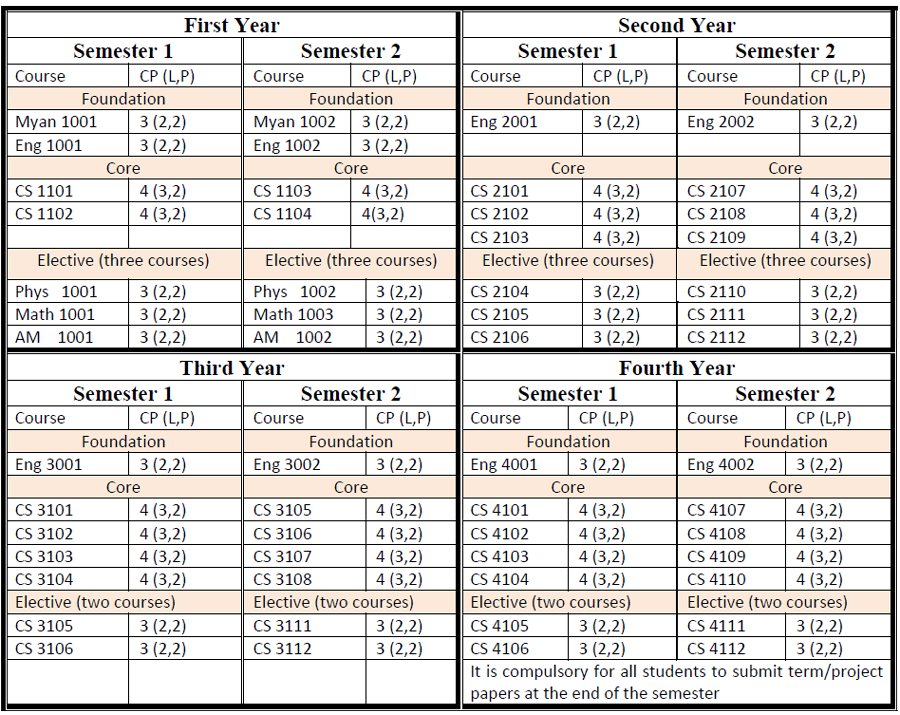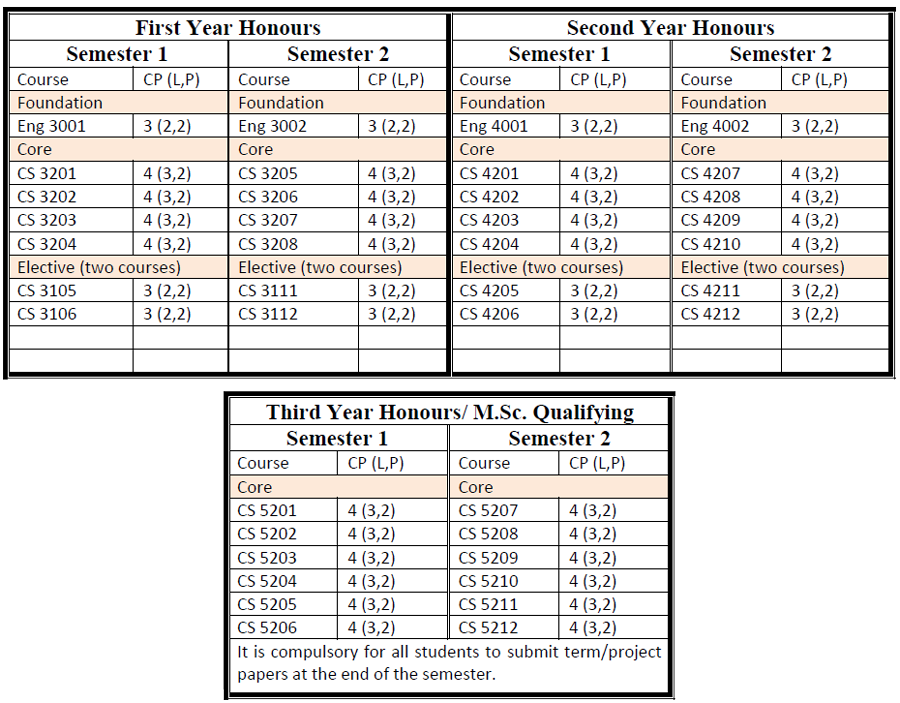
Dr. Myat Su Hlaing
ဒေါက်တာမြတ်စုလှိုင်
Position : Professor (Head)
Degree : B.Sc(Hons;)(Physics), M.Sc(Engineering Physics), M.Sc(Computer Science), Ph.D(Computer Science)
Computer Studies
Dr. Than Than Wai ဒေါက်တာသန်းသန်းဝေ
Position : Professor
Degree : B.Sc (Hons;)(Maths), M.Sc (Maths), M.Sc ( Computer Science), Ph.D (Computer Science)
Other information :
Dr Su Myo Swe ဒေါက်တာ စုမျိုးဆွေ
Position : Professor
Degree : Ph.D (Computer Science), M.Sc (Computer Science), M.Sc (Zoology), B.Sc (Honors; Zoology)
Other Information: International Diploma in Computer Studies (IDCS, NCC, UK), Global Diploma in English
Teacher list
| Sr.No | Department | Name | Position | Education | Thesis Title | Field Of Specialization | Current Research Project | Email/Gmail |
| 1 | Computer Studies | Dr.Myat Su Hlaing | Professor (Head) | Ph.D | Cluster Computing in Image Processing | Image Processing, Parallel Computing, Software Engineering | myatsuhlaingster@gmail.com |
|
| 2 | Computer Studies | Dr.Than Than Wai | Professor | Ph.D | High Performance Computing in Eigen-value Analysis with Hybrid Coding | Parallel Computing | ttlaywai@gmail.com |
|
| 3 | Computer Studies | Dr.Su Myo Swe | Professor | Ph.D | Evolutionary Computation of Optimization in Genetic Algorithm |
Database, Artifical Intelligence | sumyoswe09@gamil.com | |
| 4 | Computer Studies | Dr. Ei Swe Han | Associate Professor | Ph.D | Network Analysis for Optimal Path Routing of Emergency Transport Management System | Software Engineering | eiswehan@gmail.com |
Programmes Offered
- B.Sc. / B.Sc. (Hons) in Computer Science
Curriculum
B.Sc. in Computer Science

B.Sc. (Honours) in Computer Science
Students who passed second year with GPA greater than 4 are eligible to attend B.Sc. (Honours) classes for three more years. After finished successfully, they are earned B.Sc. (Hons) degree majoring in Computer Science.

Course Descriptions
The purpose of this module is to enable students to familiarise with the basic principles of a personal computer. The module includes the internal hardware, the operating system, software application, computer types and data types, tree structure and computing algorithm.
Students enable to learn data organizations, data structures, and algorithms. Algorithms are a step-by-step procedure for making calculations, used in data processing and automated reasoning. This creates an output that is often, but not always, predictable. Data structures provide a way of storing and organizing data in a computer so it can be used efficiently. It includes the different kinds of data structures suited to different kinds of applications and may be highly specialized to specific tasks.
This course deals with some of the problems that arise during the requirements engineering process are a result of failing to make a clear separation between these different levels of description. It is the study of functional and non-functional requirements, the software requirements document, and requirement specification.
The purpose of these modules is to enable students to know the techniques for software design in the development of large and complex software systems. It is focused on software design, architectural design and object oriented design. The course will balance an emphasis on design principles with an understanding of how to apply techniques and methods to create successful software systems. Former module describes the design process, design strategies and design quality, design methods, design description and design quality. Later module deals with system structuring, control models, modular decomposition, and domain-specific architectures.
The students can learn test planning concerning with setting out standards for the testing process rather than describing product tests. System operations are performed based on operation service standards. Operation and maintenance of a system constitute the final face of a software life cycle.
This purpose of this module is to enable students to know how to create a database and database query for database management system. A database is a collection of related data; and a database management system (DBMS) is software that manages and controls access to the database. A database application is simply a program that interacts with the database at some point in its execution. The database system is a collection of application programs that interact with the database along with the DBMS and the database itself.
This module will provide the vocabulary of concepts that is needed to understand in mathematical terms the problems that computer systems are designed to solve, and to analyze proposed solutions for their correctness and efficiency. Specifications of computer systems can be expressed formally in terms of sets, relations and functions, and the correctness of programs that implement these specifications is often proved using the techniques of mathematical logic, including reasoning based on mathematical induction. This reasoning may involve the mathematical properties of permutations, orderings, and other similar concepts. Finally, analysis of the efficiency of programs may involve solution of recurrence relations, combinatorial calculations, and the use of asymptotic approximations. All these ideas will be introduced in this course. Computational mathematics involves mathematical research in areas of science where computing plays a central and essential role, emphasizing algorithms, numerical methods.
These modules are intended for art and science of planning and leading software projects. It aims to understand a sub-discipline of project management in which software projects are planned, implemented, monitored and controlled.
It is the study of identifying, analyzing, and responding to risk factors throughout the life of a project and in the best interest of its objectives. It includes uncertainty in financial markets, threats from project failures, legal liabilities, credit risks, accidents, natural causes and disasters.
These modules deal with process and product quality, quality assurance and standards, quality planning and quality controls. Students enable to learn the process and product of concepts that is needed to understand in documentation standards, process standards, software metrics that software quality reviews are designed to solve, and to analyze proposed solutions for their correctness and efficiency.
The purpose of these modules is to introduce students with information security, database security, computer security, malware security, viruses, authentication, authorization and encryption. The student can learn the fact that security is becoming a key priority because communication and information have become a key factor in economic societal development.
The purpose of these modules is to enable student to familiarize web based system development. The World Wide Web, the highly visual, dynamic and interactive segment of the internet, dramatically changed the communication, education, entertainment, and business practices of millions of people worldwide. Former module explains the design and shows how to use the World Wide Web as to develop effective Web pages and Web sites for specific purposes and audiences. This course includes connecting to the Web, Web browsers, and search engines types of Web sites, tools for creating web pages and Web design roles. Later module deals with typography, Web maintenance, and enhancing Web pages.
In this module, students enable to learn IT in Business Management. It deals with how to build a successful marketing strategy. Students will learn consumers’ behavior, identify market segments, select distribution channels, price for profitability, and select promotional tactics. These modules emphasize on an organized system such as organization, collection, storage and communication of information. More specifically, it is the study of complementary network that people and organizations use to collect, filter process create and distribute data.
This purpose of this module is to enable students to familiarize with computer ethics: the application of classical ethical principles to the use of computer technology. The module deals with ethical and social issues related to systems, ethics in an information society, the moral dimensions of information systems, ethical responsibilities, risks and facilities of computer-based systems, intellectual property privacy and civil liberties.
It is the study of network and network protocol for topologies. Network protocol is all communication activity in Internet governed by protocols. Protocols define format, order of messages sent and received among network entities, and actions taken on message transmission, receipt.
The main aims of research methodology are to find out the truth which is hidden and which has not been discovered as yet. The student can observe the phenomena again and again from different dimensions. There are many theories of mathematical tools for analysis, research problems in management, type of research process, data collection and presentation.
It is the study of database development and implementation. Procedures to build a database (database design) are investigating and analyze the complicated information structure, various applications and requirements of the real world. In addition, student will learn how to arrange selected information into a database and how to appropriately structuralize selected data.
This course introduces an information system of operational functions and supports management decision making by providing information that managers can use the plan and control the activities of the firm. An information system is a man-made system that facilities an organizations operational functions and supports management decision making by providing information that managers can use the plan and control the activities of the firm.
This course focuses on principles of software engineering to the design, development, maintenance, testing and evaluation of the software and systems that make computers or anything comprising software work. Similarly, the role of a network engineer focuses on implementing, maintaining and developing communication networks within organizations to ensure the communication infrastructures work effectively.
In this module, students can learn creating object databases, distributive databases, xml query network as database systems, peer-peer data sharing architectures, data grids, logic foundations, semantic databases, spatial and temporal databases, and knowledge bases.
This course describes an information system management, i.e. an organized set of components for collecting, transmitting, storing, and processing data in order to deliver information to action. The courses include the changing role of information systems in organization, managers, decision making, and information systems, information system and business strategy.
These modules focus on syntax, low level features of image processing. Studying computer graphics involves using computers to create still or moving two or three dimensional images using specialized graphics hardware and software. Student will study how to manipulate visual and geometric information using computational techniques, focusing on mathematical and computational foundations of image generation and processing rather than purely aesthetic issues.
These modules describe wireless networks and mobile computing. Wireless Networks can be divided into three categories based on their technology: (1) LANs (2) extended LAN (3) mobile computing. Mobile computing will be studied from three perspectives: mobile technology, application development, and user interaction.
The study of artificial intelligence (AI) is closely related to the field of artificial life (AL), and both are involved in synthesizing goal-orientated processes such as problem-solving, decision-making, environmental adaptation, learning and communication using computers and algorithms. While the field of artificial life examines systems and studies the complex behaviors that emerge from these systems, artificial intelligence uses systems to develop specific behaviors in machines and software. AI is a cross-disciplinary topic drawing on applied mathematics, symbolic logic, semiotics, electrical engineering, philosophy (of mind), neurophysiology and social intelligence. AI involves the automation of tasks (such as evaluative and predictive tasks) in computer applications involving complex real-world data successful use of AI in this manner can act as a viable substitute for humans doing the same tasks.

